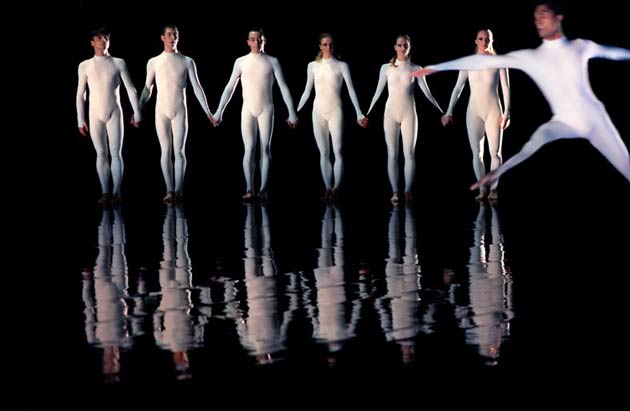Rambert triple bill, Sadler's Wells, London<br/>Royal Ballet triple bill, Royal Opera House, London
An evening of short works can be hard to bring off, as these parallel programmes show, for all their innovation and sensuality

Your support helps us to tell the story
From reproductive rights to climate change to Big Tech, The Independent is on the ground when the story is developing. Whether it's investigating the financials of Elon Musk's pro-Trump PAC or producing our latest documentary, 'The A Word', which shines a light on the American women fighting for reproductive rights, we know how important it is to parse out the facts from the messaging.
At such a critical moment in US history, we need reporters on the ground. Your donation allows us to keep sending journalists to speak to both sides of the story.
The Independent is trusted by Americans across the entire political spectrum. And unlike many other quality news outlets, we choose not to lock Americans out of our reporting and analysis with paywalls. We believe quality journalism should be available to everyone, paid for by those who can afford it.
Your support makes all the difference.Somewhere in Kansas lives a housewife who spends her life hunting down recipes that use only three ingredients. Twelve cookbooks are the result. The task of a ballet director is not dissimilar, in the search for the triple bill that ticks all the boxes – something piquant, something nourishing and something comforting in one sitting. Both Rambert and the Royal Ballet unveiled mixed programmes in London last week, and both showed – are we surprised? – how hard it is to strike the perfect balance.
The Rambert triple bill was planned, clearly, with a musical ear. The result is that, whatever you think of the dance, you get a darned good orchestral concert (and this holds true for the tour, too: Rambert doesn't skimp on live music in the provinces). The choreographer Henri Oguike has earned his spurs insinuating hyperactive movement into the architecture of classical scores, and his response to Schubert's Death and the Maiden quartet, in Mahler's rich orchestration, pushes this tendency to the limit.
The work's title, Tread Softly, completes itself in the line by WB Yeats: "... because you tread on my dreams". And it's women's dream-life, not death, that's the topic here. But there's nothing wafty-softie about Oguike's women, in their ruched white tutus that suggest crinolines with the skirts ripped away. There's nothing maidenly about them either, as they charge about, tossing migraine-heavy heads, bare feet slapping the floor, to take up poses suggestive of coitus or childbirth. Whatever the prevailing social mores, says Oguike, whether early 19th century or early 21st, women's inner lives turn on the same events.
The men get a look-in too, in frisky little stag-ruts. Or they line up to lie flat as a woman sprints the width of the stage treading along the length of their bodies, not obviously with a care for tender spots. This is not what you expect from a hallowed score, yet the boisterousness is validated by Schubert's writing, its rhythmic verve gutsily relayed by the Rambert Orchestra under Paul Hoskins.
The other new work on the bill, The Comedy of Change, is inspired by Charles Darwin. Rambert's boss Mark Baldwin has consulted a Cambridge professor (her special subject: the cognitive capacities of crows) to distil Darwin's ideas on natural selection in a way that could be useful to dance (eg, unisons break off into duets and solos to stress individuality – it's not rocket science). The result is a curate's egg, stuffed with gimmicks but sustained by a flow of uncluttered movement strongly redolent of the late Merce Cunningham. On the whole, Baldwin's ambition pays off.
Best of the gimmicks are the white-fronted, black-backed bodysuits that make dancers appear, disappear or half-appear, depending on the angle. Worst is the tin-foil human cast, which gets bashed flat like a spent seed-pod as the curtain falls. The commissioned score, by Julian Anderson, is spare and beautiful, if rather obviously in thrall to Stravinsky's Rite of Spring. Siobhan Davies's familiar Carnival of the Animals (just as much biology, less angst) is the frothy sandwich-filler.
The Royal Ballet triple bill takes a grander stance, so has further to fall. Balanchine's Agon is the opener and anchor-piece, by dint of having appeared in recent seasons. But it was oddly off-colour on first night, until Melissa Hamilton and Carlos Acosta upped the ante in their big duet: she, arch and cruel, he her lap-dog, slavish at her satin-shod feet.
Next up, a riddle: Glen Tetley's Sphinx. What was the Royal thinking of buying in a piece of Seventies tosh worthy of a Vegas floor show? Perhaps it was the music that clinched it. It's a rare treat to hear Martinu's monstrous, multiply-climactic Double Concerto – a real big-dipper ride. The dancers, too, were splendid: Rupert Pennefather a stallion of an Oedipus, Edward Watson grisly as jackal-headed death, and Marianela Nuñez a spangly siren of a sphinx, all orgasmic archings and parted lips. Heroic athletics, certainly. Taste-wise, give it another 40 years.
The best came last, with Limen, shadowy, mysterious, more sensuous than we've seen before from Wayne McGregor. It may come with all the usual guff about "exploring thresholds of darkness and light, presence and absence ..." – but these things are hard to talk about, easier to watch. Its central duet for Eric Underwood with Sarah Lamb – his dark limbs cradling her coiled white body like a solar eclipse – contains images I won't forget. A resounding reason to go.
Rambert tour: www.rambert.org
RR bill: in rep to 18 Nov (020-7304 4000)
Join our commenting forum
Join thought-provoking conversations, follow other Independent readers and see their replies
Comments